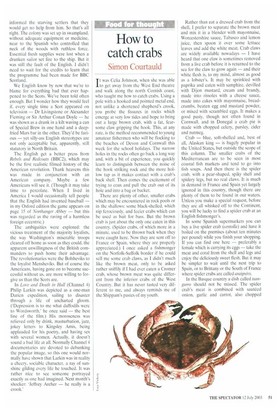How to catch crabs
Simon Courtauld
It was Celia Johnson, when she was able to get away from the West End theatre and walk along the north Cornish coast, who taught me how to catch crabs. Using a pole with a hooked and pointed metal end, not unlike a shortened shepherd's crook, you probe the fissures in rocks which emerge at very low tides and hope to bring out a large brown crab, with a fat, fearsome claw gripping the hook. This, at any rate, is the method recommended to young amateur fishermen who will be flocking to the beaches of Devon and Cornwall this week for the school holidays. The narrow holes in the rocks often go back a long way and, with a bit of experience, you quickly learn to distinguish between the noise of the hook striking rock and the more hollow tap as it makes contact with a crab's back shell. Then comes the excitement of trying to coax and pull the crab out of its hole and into a bag or bucket.
There are plenty of other, smaller crabs which may be encountered in rock pools or in the shallows: some black-shelled, which nip ferociously, and feeler crabs which can be used as bait for bass. But the brown crab is just about the only one eaten in this country, (Spider crabs, of which more in a minute, used to be thrown back when they were caught here. Now they are sent off to France or Spain, where they are properly appreciated.) I once asked a fishmonger on the Norfolk-Suffolk border if he could sell me some crab claws, as I didn't much like the brown meat, only to be asked rather sniffily if I had ever eaten a Cromer crab, whose brown meat was quite different from the inferior crabs of the West Country. But it has never tasted very different to me, and always reminds me of the Shippam's pastes of my youth.
Rather than eat a dressed crab from the shell. I prefer to separate the brown meat and mix it in a blender with mayonnaise, Worcestershire sauce, Tabasco and lemon juice, then spoon it over some lettuce leaves and add the white meat. Crab claws are widely available nowadays — I have heard that one claw is sometimes removed from a live crab before it is returned to the
sea for the claw to grow again and their white flesh is, to my mind, almost as good as a lobster's. It may be sprinkled with paprika and eaten with samphire, devilled with Dijon mustard, cream and brandy, made into rissoles with a cheese sauce, made into cakes with mayonnaise, breadcrumbs, beaten egg and mustard powder, or mixed with scrambled eggs. It makes a good pasty, though not often found in Cornwall, and in Donegal a crab pie is made with chopped celery, parsley, cider and nutmeg.
Crab — blue, soft-shelled and, best of all, Alaskan king — is hugely popular in the United States, but outside the scope of this column. The smaller crabs of the Mediterranean are to be seen in most coastal fish markets and tend to go into fish soups. And then there is the spider crab, with a pear-shaped, spiky shell and spidery legs, but no real claws. It is much in demand in France and Spain yet largely ignored in this country, though there are plenty of them to be found in our waters. Unless you make a special request, before they are all whisked off to the Continent, you will be lucky to find a spider crab at an English fishmonger's.
In some Spanish supermarkets you can buy a live spider crab (centolla) and have it boiled on the premises (about ten minutes per pound) while you finish your shopping. If you can find one here — preferably a female which is carrying its eggs — take the meat and coral from the shell and legs and enjoy the deliciously sweet flesh. But it may be simpler to wait until the next trip to Spain, or to Brittany or the South of France where spider crabs are called araignees.
In the Basque country a dish called atmgurro should not be missed. The spider crab's meat is combined with sautéed onion, garlic and carrot, also chopped
tomatoes, fish stock, white wine and paprika, then placed in the crab's shell and baked with a topping of breadcrumbs and parsley. It's a pity about the spider crab having no fat claws, but its body meat is better than that of any crab from Cromer.



































































 Previous page
Previous page